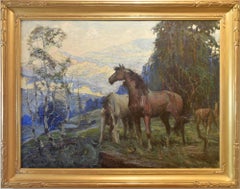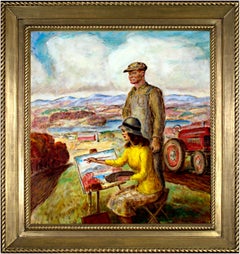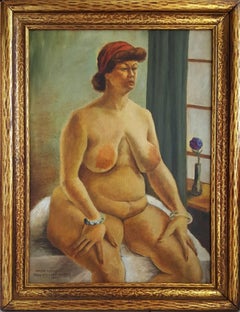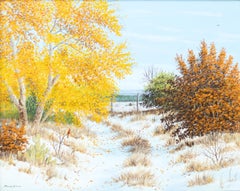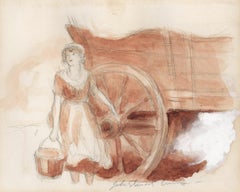John Steuart Curry Paintings
American, 1897-1946
Born in Dunavant, Kansas on November 14, 1897, John Steuart Curry became the youngest member of the famed "Benton-Wood-Curry trio" of Regional Painters of the early 20th-century American Scene movement. He gained a national reputation for his rural Kansas scenes. The artist focused on people who were down-to-earth, plain spoken, and self-reliant, and who made a living through hard physical labor.
Curry executed murals dealing with land settlement and racial justice, and his works reflecting these themes are in the Capitol Building in Kansas, the University of Wisconsin, the United States Department of the Interior, and the United States Department of Justice.
The artist quit high school and attended the Kansas City Art Institute and School of Design. He transferred to the Art Institute of Chicago.
Curry married Clara Derrick in 1923. He studied in Paris in 1927. He was not impressed by the modernist American painters, many of whom were adopting the 'isms' of French contemporary artists. Curry was determined to paint American subjects without European models and to celebrate patriotism, regional pride, and the common man.
He settled in Westport, Connecticut. In 1928, he painted Baptism in Kansas. The painting was heralded nationally as work of a new American genre. It was exhibited at the Corcoran Gallery of Art biennial where it met critical acclaim. In 1931, Gertrude Vanderbilt Whitney bought it for her museum. Tornado over Kansas was unveiled in 1929 before the stock market crash and provided the city with the romance of man versus nature theme. In 1933, it received second prize at the Carnegie International Exhibit. In 1930, he had his first one-man exhibition at the Whitney Studio Club. His work of the 1930s contains themes of work, family, and land-- demonstrating the peace, struggle, and perseverance that Curry believed was the essence of American life.
In 1934 he married Kathleen Shepard. The United States government selected him to paint murals for the Department of Justice and the Department of Interior. He was appointed Artist-in-Residence in the College of Agriculture at the University of Wisconsin in 1936.
He was a member of the Art Students' League and won prizes including: Purchase prize, North West Print Maker, fifth annual Exhibition, 1933; second prize, Thirty-first International Exhibition, Carnegie Institute, 1933; gold medal, PAFA, 1941; prize, Artists for Victory Exhibition, the Metropolitan Museum of Art, 1941. Exhibitions include: “A Celebration of Rural America,” 2007, Danville Museum of Fine Arts and History; “Collective Images: the sketchbooks of John Steuart Curry, 2002, Worcester Art Museum; “Illusions of Eden: Visions of the American Heartland,” 2000, Columbus Museum of Art; “The American Century: Art and Culture 1900-2000,” Whitney Museum of American Art; and “John Steuart Curry: Inventing the Middle West,” 1998, M.H. de Young Memorial Museum.
He died in Madison, Wisconsin in 1946.to
1
2
1
Overall Width
to
Overall Height
to
4
1
2
1
2
2
2
2
1
1
1
1
1
1
4
4
3
3
5
781
720
712
697
3
1
4
Artist: John Steuart Curry
Wild Horses
By John Steuart Curry
Located in New York, NY
Signed lower left
John Steuart Curry was born in Dunavant, Kansas, and, after training at the Chicago Art Institute, the Kansas City Art Institute and Paris’s Academie Julian, major...
Category
Early 20th Century American Impressionist John Steuart Curry Paintings
Materials
Canvas, Oil
'Cock Fight in Cuba' original Regionalist painting signed by John Steuart Curry
By John Steuart Curry
Located in Milwaukee, WI
John Steuart Curry
"Cockfight in Cuba," 1946
oil on canvas
Image: 38.25 x 46.25 in
Frame: 43.75 x 51.5 in
Signed on reverse with initials JSC on lower right stretcher bar
John Steu...
Category
1940s American Realist John Steuart Curry Paintings
Materials
Canvas, Oil
'Sketching Wisconsin' original oil painting, Signed
By John Steuart Curry
Located in Milwaukee, WI
John Steuart Curry
"Sketching Wisconsin," 1946
oil on canvas
31.13 x 28 inches, canvas
39.75 x 36.75 x 2.5 inches, frame
Signed and dated lower right
Overall excellent condition
Presented in a 24-karat gold leaf hand-carved wood frame
John Steuart Curry (1897-1946) was an American regionalist painter active during the Great Depression and into World War II. He was born in Kansas on his family’s farm but went on to study art in Chicago, Paris and New York as young man. In Paris, he was exposed to the work of masters such as Peter Paul Rubens, Eugène Delacroix and Jacques-Louis David. As he matured, his work showed the influence of these masters, especially in his compositional decisions. Like the two other Midwestern regionalist artists that are most often grouped with him, Grant Wood (American, 1891-1942) and Thomas Hart Benton (American, 1889-1975), Curry was interested in representational works containing distinctly American subject matter. This was contrary to the popular art at the time, which was moving closer and closer to abstraction and individual expression.
Sketching Wisconsin is an oil painting completed in 1946, the last year of John Steuart Curry’s life, during which time he was the artist-in-residence at the University of Wisconsin in Madison. The painting is significant in Curry’s body of work both as a very revealing self-portrait, and as a landscape that clearly and sensitively depicts the scenery of southern Wisconsin near Madison. It is also a portrait of the artist’s second wife, Kathleen Gould Curry, and is unique in that it contains a ‘picture within a picture,’ a compositional element that many early painting masters used to draw the eye of the viewer. This particular artwork adds a new twist to this theme: Curry’s wife is creating essentially the same painting the viewer is looking at when viewing Sketching Wisconsin.
The triangular composition of the figures in the foreground immediately brings focus to a younger Curry, whose head penetrates the horizon line and whose gaze looks out towards the viewer. The eye then moves down to Mrs. Curry, who, seated on a folding stool and with her hand raised to paint the canvas on the easel before her, anchors the triangular composition. The shape is repeated in the legs of the stool and the easel. Behind the two figures, stripes of furrowed fields fall away gently down the hillside to a farmstead and small lake below. Beyond the lake, patches of field and forest rise and fall into the distance, and eventually give way to blue hills.
Here, Curry has subverted the traditional artist’s self-portrait by portraying himself as a farmer first and an artist second. He rejects what he sees as an elitist art world of the East Coast and Europe. In this self-portrait he depicts himself without any pretense or the instruments of his profession and with a red tractor standing in the field behind him as if he was taking a break from the field work. Here, Curry’s wife symbolizes John Steuart Curry’s identity as an artist. Compared with a self-portrait of the artist completed a decade earlier, this work shows a marked departure from how the artist previously presented and viewed himself. In the earlier portrait, Curry depicted himself in the studio with brushes in hand, and with some of his more recognizable and successful canvases behind him. But in Sketching Wisconsin, Curry has taken himself out of the studio and into the field, indicating a shift in the artist’s self-conception.
Sketching Wisconsin’s rural subject also expresses Curry’s populist ideals, that art could be relevant to anyone. This followed the broad educational objectives of UW’s artist-in-residence program. Curry was appointed to his position at the University of Wisconsin in 1937 and was the first person to hold any such position in the country, the purpose of which was to serve as an educational resource to the people of the state. He embraced his role at the University with zeal and not only opened the doors of his campus studio in the School of Agriculture to the community, but also spent a great deal of time traveling around the state of Wisconsin to visit rural artists who could benefit from his expertise. It was during his ten years in the program that Curry was able to put into practice his belief that art should be meaningful to the rural populace. However, during this time he also struggled with public criticism, as the dominant forces of the art market were moving away from representation. Perhaps it was Curry’s desire for public acceptance during the latter part of his career that caused him to portray himself as an Everyman in Sketching Wisconsin.
Beyond its importance as a portrait of the artist, Sketching Wisconsin is also a detailed and sensitive landscape that shows us Curry’s deep personal connection to his environment. The landscape here can be compared to Wisconsin Landscape of 1938-39 (the Metropolitan Museum of Art), which presents a similar tableau of rolling hills with a patchwork of fields. Like Wisconsin Landscape, this is an incredibly detailed and expressive depiction of a place close to the artist’s heart. This expressive landscape is certainly the result of many hours spent sketching people, animals, weather conditions and topography of Wisconsin as Curry traveled around the state. The backdrop of undulating hills and the sweeping horizon, and the emotions evoked by it, are emphatically recognizable as the ‘driftless’ area of south-central Wisconsin. But while the Metropolitan’s Wisconsin Landscape conveys a sense of uncertainty or foreboding with its dramatic spring cloudscape and alternating bands of light and dark, Sketching Wisconsin has a warm and reflective mood. The colors of the foliage indicate that it is late summer and Curry seems to look out at the viewer approvingly, as if satisfied with the fertile ground surrounding him.
The landscape in Sketching Wisconsin is also revealing of what became one of Curry’s passions while artist-in-residence at UW’s School of Agriculture – soil conservation. When Curry was a child in Kansas, he saw his father almost lose his farm and its soil to the erosion of The Dust Bowl. Therefore, he was very enthusiastic about ideas from UW’s School of Agriculture on soil conservation methods being used on Wisconsin farms. In Sketching Wisconsin, we see evidence of crop rotation methods in the terraced stripes of fields leading down the hillside away from the Curry’s and in how they alternate between cultivated and fallow fields.
Overall, Sketching Wisconsin has a warm, reflective, and comfortably pastoral atmosphere, and the perceived shift in Curry’s self-image that is evident in the portrait is a positive one. After his rise to favor in the art world in the 1930’s, and then rejection from it due to the strong beliefs presented in his art, Curry is satisfied and proud to be farmer in this self-portrait. Curry suffered from high blood...
Category
1940s American Realist John Steuart Curry Paintings
Materials
Canvas, Oil
Rubenesque nude woman . full figure Nude Regionalism - "Hilda Nellis"
By John Steuart Curry
Located in Miami, FL
Plump, fleshy, or a voluptuous nude - you describe it as you see it.
Signed, titled, and dated lower left: John Steuart Curry / 1934 "Hilda Nellis".
The present work depicts a natur...
Category
1930s American Realist John Steuart Curry Paintings
Materials
Oil
Related Items
"Texas Hill Country Springtime Bluebonnets and Wildflowers" Nature Landscape
By William A. Slaughter
Located in Austin, TX
Canvas Size: 11 x 14 in.
Frame Size: 18 x 21 in.
Signed, bottom left "W. A. Slaughter '75"
This luminous oil on canvas captures the happiness and optimism of a spring landscape in T...
Category
1970s American Impressionist John Steuart Curry Paintings
Materials
Canvas, Oil
Snowy Landscape w Cardinal
By Manuel Garza
Located in Austin, TX
"Snowy Landscape w Cardinal" by Manuel Garza
Oil on Canvas
16 x 20 inches
Framed size 24 x 28"
A serene, naturalistic rendition of a forested Texas l...
Category
Late 20th Century American Impressionist John Steuart Curry Paintings
Materials
Canvas, Oil
Columbus Avenue NYC c. 1920s/30s American Scene Ashcan WPA Modern 20th Century
By Bernard Gussow
Located in New York, NY
Columbus Avenue NYC c. 1920s/30s American Scene Ashcan WPA Modern 20th Century
"Late Afternoon, Columbus Avenue, New York", impasto oil on canvas, signed lower left, signed verso (under relining, shown in photo), and titled verso on stretcher, in maple mitered cove frame, 23 1/4" x 27 1/4", SS: 19 1/4" x 23 1/4", Relined.
BIO
Russian-born Gussow trained at the Art Students League and the National Academy of Design. He also studied under Bonnat at the Ecole des Beaux-Arts in Paris. His first claim to fame was exhibiting two works at the Armory Show in 1913. Gussow exhibited at the Society of Independent Artists between 1917 and 1934 and at Salons of America in the 1930s.
The Whitney Museum of American Art, for example, has his Subway Stairs. The Barnes Foundation...
Category
1920s American Realist John Steuart Curry Paintings
Materials
Canvas, Oil
"Old Shoemaker" Ashcan 20th Century Modernism 1924 California WPA Realism Worker
By Otis Oldfield
Located in New York, NY
"Old Shoemaker" Ashcan 20th Century Modernism 1924 California WPA Realism Worker. Signed “Otis Oldfield” lower left. 14 x 12 inches.
Exhibited: Galerie des Beaux Arts, San Francisco, CA, 1925
Provenance: Estate of the Artist
Born in Sacramento, CA on July 3, 1890, Otis Oldfield left high school at age 16 to work in a local print shop. In 1909 he arrived in San Francisco and enrolled at the Best Art School. After working for two years as a bellhop at the Argonaut Hotel and as a hat check boy at the Cliff House, he had saved enough money for further studies in Paris. In 1911 he sailed for France and enrolled at Académie Julian. Caught up in the activities of wartime Paris, he was an apprentice for a book...
Category
1920s American Realist John Steuart Curry Paintings
Materials
Canvas, Oil
“The Newspaper Boy”
Located in San Francisco, CA
The classic hard luck, independent kid, maybe 8 or 10 years old here, selling the day’s papers out on the grubby streets of early 1900s New York City. He’s paused in a quiet spot, ap...
Category
Early 1900s American Realist John Steuart Curry Paintings
Materials
Canvas, Oil
A Western Mountain Scene
Located in San Francisco, CA
Snow-topped jagged peaks reflected in a mountain lake come together in this ethereal landscape painting by noted American artist Courtney Luther Miles (1887-1975). Self-taught and ac...
Category
Mid-20th Century American Impressionist John Steuart Curry Paintings
Materials
Canvas, Oil
Street of the Old Quarter British School signed Cade oil on canvas painting
Located in Sitges, Barcelona
**Technical Sheet**
**Title:** "Street of the Old Quarter"
**Author:** British School, 19th Century
**Date:** 1892
**Technique:** Oil on canvas
**Dimensions:** 14.17 x 10.63 inc...
Category
1890s American Realist John Steuart Curry Paintings
Materials
Canvas, Oil
$762 Sale Price
45% Off
H 14.18 in W 10.63 in
"Cove" Oil Painting
By Leigh Ann Van Fossan
Located in Denver, CO
Leigh Ann Van Fossan's "Cove" is an original, handmade oil painting that depicts bright teal colored cove where water meets the shore and the atmospheric pastel sky reflects in the b...
Category
2010s American Impressionist John Steuart Curry Paintings
Materials
Oil, Canvas
A nude - Realistic oil painting, Warm tones, Young Polish artist
Located in Warsaw, PL
AGNIESZKA STAAK-JANCZARSKA (born in 1994)
A graduate of the State Secondary School of Art of Józef Kluza in Krakow. In 2020, she graduated from the Academy of Fine Arts in Krakow in ...
Category
2010s Naturalistic John Steuart Curry Paintings
Materials
Cardboard, Oil
$293
H 13.19 in W 8.67 in
"Nude with Light Blue" Oil Painting
By Jacob Dhein
Located in Denver, CO
Jacob Dhein's (US based) "Nude with Light Blue" is an oil painting that depicts a nude female figure with her black robe parted with a white patterned background
Bio/artist statement:
Jacob Dhein was interested in art as a child. Crayons and colored pencils were his tools of expression. He spent hours intricately crafting drawings of comic book heroes and animals. By the time he graduated from high school, one of his drawings was exhibited on the wall of a local bank. It wasn't until he was a sophomore at the University of Wisconsin-Oshkosh that he decided to take a drawing class. He found this so compelling that he continued with sculpture and painting. During this time he met several accomplished and influential artists who encouraged him to pursue a career in art. Tc Farley...
Category
2010s American Realist John Steuart Curry Paintings
Materials
Oil, Panel
NYC EL American Scene Social Realism Mid 20th Century Modern WPA Era Figurative
By Cecil Crosley Bell
Located in New York, NY
NYC EL American Scene Social Realism Mid 20th Century Modern WPA Era Figurative
Cecil Bell (1906 – 1970)
Street Life Under the EL
22 x 30 inches
Oil on canvas, c. 1930s
Signed upper...
Category
1930s American Realist John Steuart Curry Paintings
Materials
Canvas, Oil
A Peaceful Country Lane
Located in San Francisco, CA
There’s a gentle hand in Emanuel Matthews’ landscapes, exhibiting here and in other pieces a fondness for a more bucolic, genteel and barely industrialized America. Although painted ...
Category
20th Century American Impressionist John Steuart Curry Paintings
Materials
Canvas, Oil
Previously Available Items
Study for the Mural "Westward Movement"
By John Steuart Curry
Located in Fairlawn, OH
Study for the Mural "Westward Movement"
Graphite, watercolor, gouache and paint on paper, 1936
Signed in pencil lower center (see photo)
A study leading up to his mural Justice of th...
Category
1930s American Realist John Steuart Curry Paintings
Materials
Gouache
John Steuart Curry paintings for sale on 1stDibs.
Find a wide variety of authentic John Steuart Curry paintings available for sale on 1stDibs. You can also browse by medium to find art by John Steuart Curry in paint, gouache, oil paint and more. Not every interior allows for large John Steuart Curry paintings, so small editions measuring 9 inches across are available. Customers who are interested in this artist might also find the work of Ernest Fiene, Paul Zimmerman, and Pruett Alexander Carter. John Steuart Curry paintings prices can differ depending upon medium, time period and other attributes. On 1stDibs, the price for these items starts at $5,500 and tops out at $652,500, while the average work can sell for $17,750.
Artists Similar to John Steuart Curry
Questions About John Steuart Curry Paintings
- 1stDibs ExpertMarch 22, 2022John Steuart Curry is known for his paintings that captured daily life in rural areas of Kansas. Curry was born in Dunavant, Kansas, in 1897. He painted two murals for the Kansas State Capitol in Topeka: Kansas Pastoral and Tragic Prelude. You'll find a variety of John Steuart Curry art on 1stDibs.
